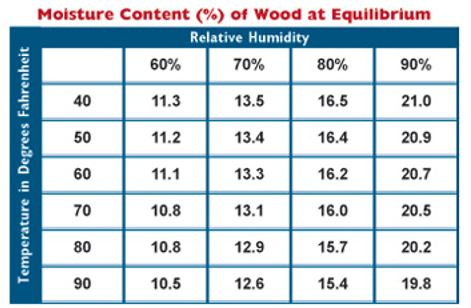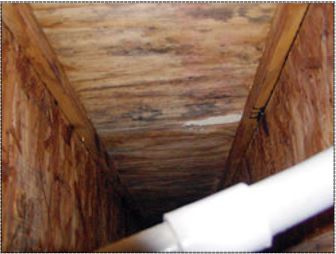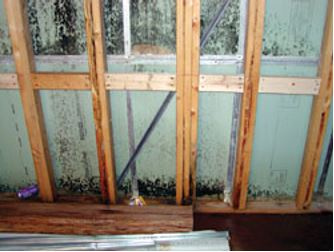Mold & Construction
Mold & Construction
The article below was originally published in the January/February 2003 edition of SBC Magazine.
According to some media reports, toxic mold poses a major risk to the health of Americans. Although there is little scientific basis for these claims, the headlines have caused many homeowners to focus on mold. It is no surprise that building owners are finding mold more often now than in the past. Mold does occur more frequently in buildings than it did twenty years ago, because of changes in the way we build, operate and maintain buildings. While people should inspect the buildings in which they live and work, they should not become alarmed or overreact when a small amount of mold is discovered. Rather, they should seek to find the underlying moisture problem that needs to be corrected.
Mold is frequently being identified on wood and paper faced gypsum board during construction. Wetting of materials by liquid water, most often rain, permits mold growth. The good news is that mold occurring during construction is usually easy to manage if the source of wetting is eliminated. Some minor changes in the design of buildings and in the construction process can significantly reduce the occurrence of mold during construction.
Mold Basics
Molds are classified in the kingdom of fungi because they differ significantly from bacteria, plants and animals. Molds cannot produce their own food from the sun (photosynthesis); rather, they obtain their energy from plants, animals, bacteria and other fungi. Molds lack an internal digestive system so they secrete, or release, enzymes that decompose food into smaller molecules that they can absorb. Molds are saprophytes, meaning that they decompose material that once was alive. Only a few of the fungi can infect or destroy living organisms.
Molds require three factors to grow: water, oxygen and nutrients. In addition, molds require temperatures between 40° F and 100° F. Molds can grow by local extension to produce the fuzzy clumps of filaments (hyphae) that are visible without magnification. When conditions are less favorable (decreasing availability of water or nutrients) molds produce spores, tiny seed-like particles. Some spores can travel great distances carried by the wind, while other spores are canoe-shaped and can float on a stream of water. When spores arrive at a favorable location that has water and nutrients, they germinate (begin to grow). The term “mold” actually refers to the fuzzy appearance that colonies of fungi produce when growing on the surface of wood or paper faced products.
As a result of the digestion of nutrients and other biological reactions, molds produce chemicals called volatile organic compounds (VOCs). These VOCs become airborne and some of them are responsible for the musty smell that humans perceive as “moldy.” While these VOCs may be offensive to many people, they are not thought to be toxic, that is, to cause illness. Some molds at certain times do produce toxic chemicals called “mycotoxins.” When mycotoxins are produced, they are present on the surface of mold filaments and spores. These mycotoxins inhibit the growth of bacteria and other species of mold, thus providing a competitive advantage to slow growing molds and especially to spores when they germinate. Penicillin and some other antibiotics are “mycotoxins” that are useful to humans. Some mycotoxins can cause illness in humans if a sufficient quantity of the toxin gets into the body.
When a spore lands on a surface that has sufficient water and a source of nutrition, the spore will begin to grow. Mold spores can begin to grow on the paper facing on gypsum board that remains wet for 48 hours. Solid lumber must remain sufficiently wet for approximately seven days before mold begins growing. The availability of water at the surface of lumber and engineered wood products is critical for mold growth. Although many factors such as temperature affect the water activity at the surface of wood, moisture content above 19 percent for approximately a week is required for significant mold growth to occur on wood. Wood decay fungi that can actually destroy wood require much wetter conditions and start growing when the moisture content by weight is greater than 28 percent. Wood species vary in their susceptibility to decay by fungi and in the specific moisture content at which growth begins.
The moisture content of wood can be measured with reasonable accuracy with a resistance pintype moisture meter. The meter measures the resistance to the passage of a small electrical current through the wood and then converts the resistance to moisture content. Since the electrical resistance of wood species varies slightly at any specific moisture content, the moisture reading is the approximate moisture content. Some moisture meters can be set for specific wood species or the moisture content obtained from the meter can be corrected for the specific species.
Molds & Wood Frame Construction
Molds and fungi cause staining of newly cut logs within five to six days when conditions are warm and humid. Constantly wetting logs during storage or rapidly cutting the logs into lumber followed by drying of the lumber can prevent staining. Stains are most commonly bluish to bluishblack or gray to brown, but occasionally can be yellow, orange or purple. The color of the stain varies depending on the species and moisture content of the wood as well the specific fungi infecting the wood. Staining of lumber usually does not affect any property of the wood other than appearance.
Wood decay fungi require much higher moisture levels to grow than the superficial molds do. The wood moisture content must be above the fiber saturation point (at least 28 percent by weight, varying for different species) before the wood decay fungi can begin to destroy wood. But too much water will inhibit wood decay fungi allowing submerged logs to often last for decades.
Surface mold growth on lumber occurs on most species of wood when the moisture content by weight is between 20 and 28 percent. In most situations, this mold growth is a superficial phenomenon that does not affect the strength or long-term durability of the wood. Some mold species can penetrate juvenile lumber leading to a decrease in strength.

TABLE 1. DATA ABSTRACTED FROM TABLE 4-3, ON PAGE 3-7 OF WOOD HANDBOOK—WOOD AS AN ENGINEERING MATERIAL. FOREST PRODUCTS LABORATORY. 1999.
Lumber is classified as “airdried” when its moisture content is brought down to below 19 percent through an air drying process prior to shipping, while “kiln-dried” lumber uses a heated kiln to dry lumber below 19 percent and is designated as either KD-19 or KD-15 to represent the kiln drying process that leaves the lumber at 19 or 15 percent moisture content respectively. Mold will not grow on the surface of air-dried or kilndried lumber unless re-wetting occurs by liquid water or prolonged exposure to very high relative humidities. Table 1 shows the equilibration moisture content for wood at specific temperatures and relative humidity. (This data is abstracted from Table 4-3 of the Wood Handbook of the USDA Forest Products Laboratory).
Contrary to popular belief, exposure of lumber to hot, humid conditions in the southern United States does not lead to mold growth. Rather, it is the wetting of lumber by rain or condensation that facilitates mold growth in this climate. The moisture content of wood is determined by the relative humidity of air rather than the absolute humidity (total moisture content of the air). During periods of hot, humid weather, wood will actually be drying for much of the day (see Table 1). The greatest risk of mold growth due to ambient conditions occurs during cooler months when the relative humidity remains above 90 percent for sustained periods, resulting in wood moisture contents above 19 percent.
One building practice in the north that frequently leads to mold growth is pouring concrete basements late in the autumn, installing the first floor deck and then covering the deck with an impermeable tarp for the winter. The fresh concrete provides a moisture source that maintains relative humidity under the tarp near 100 percent. With the temperature in the basement hovering around 40° F, ideal conditions are created for the growth of mold and potentially wood decay fungi.
Buildings with crawl spaces frequently have mold on the floor trusses and the underside of the floor sheathing that appears before the end of construction. Ground moisture that is not contained by a vapor barrier or rain that pools on the crawl space floor provides the moisture necessary to support mold growth. Figure 1 shows mold that grew in a crawl space of a building in Florida. Rain wetted the sand layer installed on top of the ground cover (vapor barrier) thereby providing a large moisture reservoir. The I-joists and the floor sheathing had moisture contents of between 25 and 30 percent. Wood decay fungi could destroy this wood if it remained wet. Framing lumber and sheathing that were above the first floor deck had moisture contents of between eight and 12 percent in spite of frequent wetting by rain. Solar radiation and ventilation when it was not raining were able to quickly dry this framing. The air in the crawl space maintained a relative humidity near 100 percent, preventing any drying of the floor trusses and sheathing.
Air-dried or kiln-dried lumber can be re-wetted by rain, ground water or condensation that is then trapped by impermeable coverings. To minimize moisture exposure, lumber and wood products can be stored off the ground and protected from rain. If covers or tarps remain over wood for prolonged periods, they should be constructed of a permeable material that repels liquid water but allows the passage of water vapor. Otherwise moisture becomes trapped under the cover and the moisture content of the wood rises above the threshold at which mold begins to grow.

Figure 1. Mold in crawl space during construction. The underside of the floor sheathing and the Ijoists have elevated moisture contents (25-30 percent by weight) as well as mold growth. Rain collected on the crawl space floor providing a moisture reservoir that maintained a relative humidity near 100 percent.
To prevent mold growth, wood must either be protected from wetting by liquid water or allowed to dry within a reasonable time. Wetting of hygroscopic materials (those that can absorb water) such as wood can occur within minutes. Drying of hygroscopic materials occurs by evaporation or diffusion both of which are much slower processes. Evaporation requires energy and is accelerated by ventilation. Wood trusses that are not protected from wetting may trap water between wood surfaces and remain wet long enough to initiate mold growth. Although the metal plates that join the components of the truss provide a small space that facilitates drainage and ventilation, banding that occurs away from the plates can trap water and reduce drying. Preventing mold growth between wood trusses requires protection from wetting or an effective mechanism for drying.

Figure 2. Extensive mold growth on paper facing of gypsum board in fire wall between adjoining town homes. Minimal mold growth is present on the wood framing. Roofs between these two units had not been sealed allowing rain to penetrate the enclosure and wet this wall. (Photography by Nathan Yost, Building Science Corp.)
Rain frequently will wet framing lumber before the building is weather tight but mold will not grow unless it remains wet. Therefore, water should be drained or removed from horizontal surfaces such as floors and ventilation increased to facilitate drying. If the wetting is only transient, mold will not grow on the wood.
In multifamily buildings and town homes, the party wall or firewall between units is frequently left un-covered for weeks to months. Mold frequently occurs on the paper-faced gypsum board and framing on these walls (see Figure 2). Some builders have attempted to hold the manufacturers of trusses or wall panels responsible for the mold growth on these walls. This is despite the fact that adjacent wall panels and trusses are free of mold and have moisture contents below sixteen percent. All the wall panels were manufactured at the same time and transported together to the jobsite. The difference is that the panels installed in the party wall were frequently wetted by rain through the unfinished section of the roof whereas the other walls were protected from rain and did not get wet. Gypsum board without paper facing or a firewall that does not require gypsum in between walls can prevent mold in this location.
Dealing with Mold During Construction
While superficial mold that occurs on lumber does not affect the performance of the wood, the general public increasingly perceives it as a problem. Superficial mold can be easily removed by scrubbing with water and detergent followed by rinsing. The moisture content of the wood should be less than fifteen percent before interior sheathing encloses the wood. Increasing ventilation or heat lamps can accelerate drying.
The goal of mold remediation is the removal of most of the mold; it is not necessary to kill the mold to remove the mold. A dilute bleach solution does kill mold, but it does not remove the mold.
The clean-up of mold is the same regardless of the species of mold present. Therefore, it is not necessary to test for mold once it has been identified. Testing air samples for mold is rarely useful in any building and is of no value in a new building during construction. The mold clean-up is done when the involved area is free of dust and no material transfers to a clean cloth or glove that is wiped across the involved surface. If residual staining is present or the mold has penetrated a surface of a material that is not easily removed (a structural beam for example), it can be encapsulated with a permeable latex paint. Some paints contain zinc, an inhibitor of mold growth. Moisture content of wood should be less than fifteen percent as measured with a resistance-type pin moisture meter before encapsulation with paint or enclosure with interior sheathing.
Health Effects of Mold
Sensational headlines have proclaimed that people are sick and dying as a result of exposure to toxic mold. There is no scientific proof to most of these claims. Although molds can trigger attacks of asthma or hay fever in sensitized individuals, there is no conclusive evidence that exposure to molds in buildings causes asthma or hay fever. Molds and fungi rarely cause infection in normal humans, although some fungi can cause infections in people who have weakened immune systems. Mycotoxins in contaminated foods have caused illness in animals and humans. However, there is no evidence that human illness has been caused by the inhalation of mycotoxins even in buildings where mycotoxin-producing molds have been identified. Mycotoxins are large molecules that are attached to mold spores and mold body parts that do not easily become air-borne. Consequently, unless the moldy material is disturbed, little if any of the mycotoxin will be present in the air. The spores of Stachybotrys chartarum are quite sticky and therefore tend to remain on the surface where they are growing. Consequently, very little Stachybotrys chartarum will be in the air even when there is extensive growth of this mold inside a building. No inhalation exposure can occur when the mold remains on the surfaces and not in the air.
Although there is no evidence to support the claims that mycotoxins are causing illness in humans, prudent avoidance is still advised. Active mold growth indicates an underlying moisture problem that should be corrected. Moisture also permits the growth of bacteria and dust mites that may cause illness by themselves or in concert with molds. Since mold can damage susceptible materials, it should not be ignored. When mold is identified, do the following:
- Identify and correct the underlying moisture problem.
- Remove damaged material that cannot be cleaned.
- Scrub moldy surfaces with detergent and water, rinse and allow to dry before painting or enclosing.
Dr. Yost is a medical doctor who has practiced clinical medicine for more than 20 years. After studying modern construction practices for 18 months, Dr. Yost joined Building Science Corporation, giving seminars on basic building science as well as healthy home construction. He also investigates buildings with mold and moisture problems.
